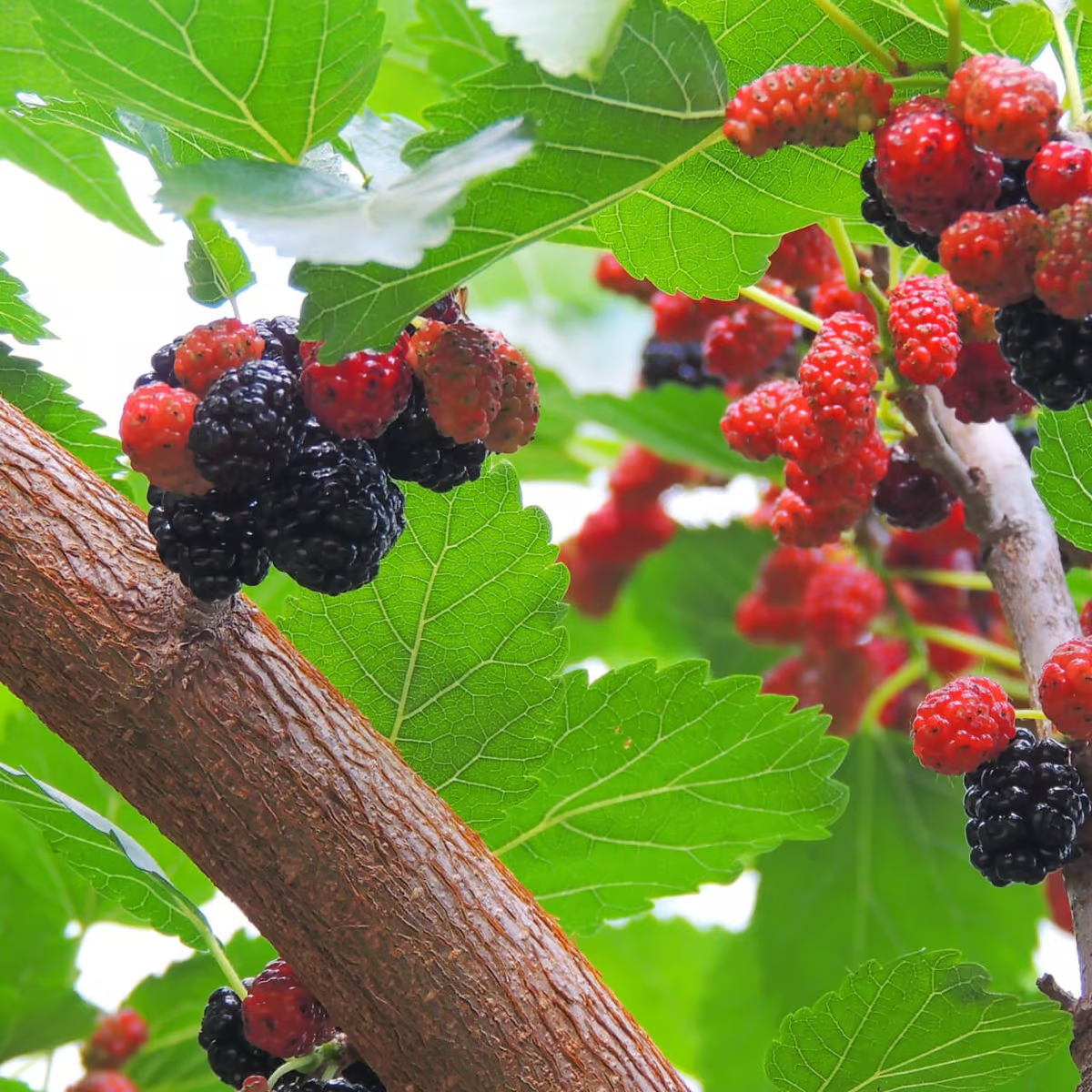
perennial plants for sales
Provides excellent shade and shelter
Fast-growing, quickly fills space
Adaptable to various soil conditions
Thrives in
ZONE 4ZONE 5ZONE 6ZONE 7ZONE 8Planting Season:
Nov-AprilWhen you add one plant to cart, it automatically adds the second one free on Bogo deals.
The White Mulberry Tree is a unique and highly sought-after addition to any garden or landscape. This remarkable tree is known for its exquisite appearance, with vibrant green leaves that provide a lush canopy of shade.
However, what truly sets them apart is their production of sweet, creamy white berries that are packed with nutrients. These berries have a delightful balance of sweetness and subtle tartness.
Hardy and resilient, they thrive in almost any type of climate and soil type, offering a low-maintenance option for both beginner and seasoned gardeners. This fast-growing type is ideal for those looking to establish a fruit-bearing landscape quickly. At the same time, its graceful form adds an appeal that complements both organic and modern garden designs.
A natural choice for those who want to enjoy a bounty of fruit while enhancing their outdoor space, they promise to bring beauty and flavor for years.
How long does it take for it to fruit?
They fruit within the 2nd to 3rd year of setting the plant. Other types can take at least 5 years to bear fruits fully, subjected to environmental conditions and proper tending.
What is the lifespan of them?
They can live up to between 75-100 years, or even more in case the conditions are appropriate. They are used in landscaping and for fruit production.
How to tell if it is male or female?
Male white mulberry trees have only the male reproductive structures, while the females contain the fruiting structures. You can identify the difference during flowering: male flowers are also smaller and arranged in clusters, while female flowers are larger and round and developed singularly and in clusters.

Height at Maturity
Over 25 Feet
Care
White Mulberry trees thrive in well-drained soil and benefit from regular watering, especially during dry periods. They should be trimmed in winter to preserve shape and remove dead branches. In spring, they should be fertilized annually with a balanced fertilizer. Mulch near the bottom to retain moisture and control weeds.
Plant Reproduction
White Mulberry trees spread through seeds, root suckers, and bird droppings.
Plant fruit trees in early spring or late fall when the weather is cool. Choose a sunny location with well-drained soil. Dig a hole twice the width of the roots and double as deep as the root system. When the tree is put in the hole, make sure the graft union (a noticeable bump where the tree was grafted above the rootstock) is above the soil line. Put dug-out soil around the tree roots, gently firmly remove air pockets, and water thoroughly.
Water young trees regularly, especially during dry spells, to establish a robust root system. Once established, water deeply and less frequently. Prune fruit trees yearly during the dormant season to remove dead or diseased wood, improve air circulation, and shape the tree for optimal fruit production. Fertilize in early spring and thin the fruit when necessary to prevent overbearing, which can stress the tree and reduce fruit quality.
Shipping date depends on the date displayed and chosen when you order from the product's page.
We only accept returns on plants verified dead. If you think your plants have died, we offer a 1 year warranty, please use use this File a Claim Link to verify dead plants and start with return warranty process.


Delicious Berries:
Mulberry trees produce sweet, nutritious berries perfect for eating fresh or making jams.
Rapid Growth:
Known for rapid growth, Mulberry trees provide shade and fruit quickly.
Multiple Uses:
Ideal as a shade tree, fruit tree, or ornamental plant, enhancing garden aesthetics.
Attracts Wildlife:
Draws birds, butterflies, and beneficial insects, boosting garden biodiversity.
Caring Tips
Each box contains detailed care instructions and information about your product. But here's the basics.
Care Tips
White Mulberry trees thrive in well-drained soil and benefit from regular watering, especially during dry periods. They should be trimmed in winter to preserve shape and remove dead branches. In spring, they should be fertilized annually with a balanced fertilizer. Mulch near the bottom to retain moisture and control weeds.
Light Requirements
White Mulberry trees thrive in full sun, requiring at least 6-8 hours of direct sunlight daily. They can tolerate some partial shade, but total sun exposure is best for optimal fruit production and growth.
Hardy Planting Zones
4 • 5 • 6 • 7 • 8
How often should I water my plants?
How do I know if my plant is getting too much or too little sunlight?
What should I do to prepare my plants for winter?
What are the signs that my plant needs fertilizing?
How can I prevent pests from damaging my plants?
How do I choose the right plant for my climate zone?